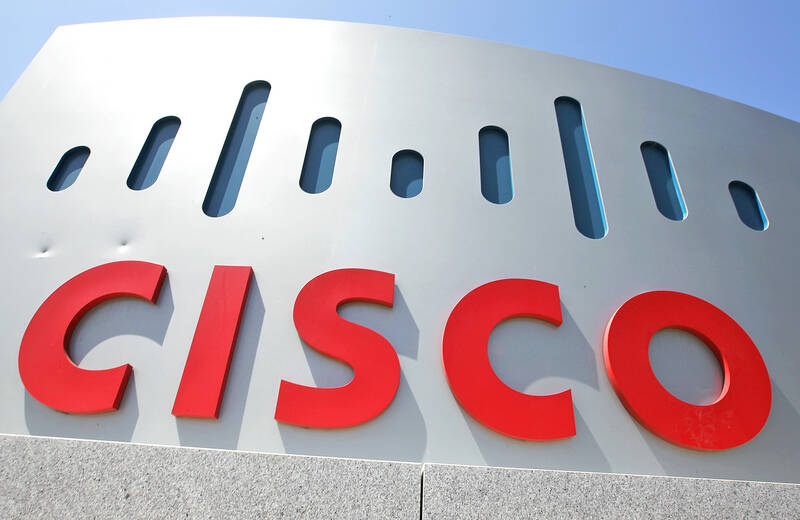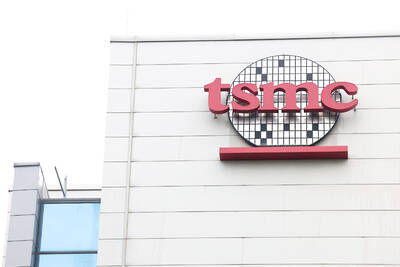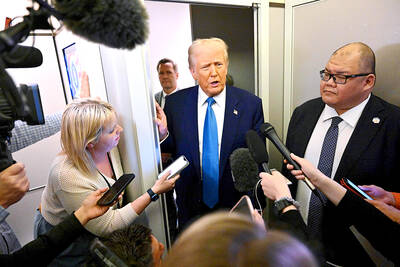Cisco Systems Inc, the largest maker of networking equipment, plans to cut thousands of jobs after a slowdown in corporate technology spending wiped out its sales growth.
A restructuring plan would affect about 5 percent of Cisco’s workforce, the company said on Wednesday.
It had almost 85,000 employees as of last year, suggesting that the move would involve approximately 4,000 jobs. The restructuring is to cost about US$500 million, Cisco said.

Photo: AP
The announcement accompanied a forecast that fell far short of what Wall Street was projecting, sending Cisco shares tumbling in late trading.
Customers are worried about the state of the economy, prompting them to delay orders and rethink how much equipment they need, Cisco chief executive officer Chuck Robbins told analysts on a conference call.
“Customers are pushing things out and putting a bit more scrutiny on them,” he said.
Cisco joins many of the largest technology companies in scaling back. Nearly 35,000 job cuts have been announced this year, according to Layoffs.fyi, which has been tracking technology layoffs since the COVID-19 pandemic.
Sales would be US$12.1 billion to US$12.3 billion in the fiscal third quarter, which ends in April. That compares with an average analyst estimate of US$13.1 billion. Excluding certain items, profit would be US$0.84 to US$0.86 per share, versus a prediction of US$0.92.
For this financial year, the company is now predicting a range of US$51.5 billion to US$52.5 billion. Earnings per share would be US$3.68 to US$3.74, excluding some items. Both of those targets are below what Wall Street is projecting.
Cisco’s adjusted gross margin — the percentage of sales remaining after deducting the cost of production — is expected to be 66 percent to 67 percent this quarter.
In Cisco’s fiscal second quarter, which ended on Jan. 27, revenue fell 6 percent to US$12.8 billion. That was the company’s first contraction in three years. Profit was US$0.87 per share, minus some items.
Analysts had estimated revenue of US$12.7 billion and earnings per shares of US$0.92.
Orders declined 12 percent in the fiscal second quarter and there would not be a quick recovery in the second half as the company had previously hoped, Robbins said.
The company had said that it has been hit by a temporary “pause” in orders from customers, who are busy installing equipment they have already acquired. While that supply logjam should resolve itself in the second half of this year, weak spending by telecoms would likely persist longer than previously projected, Cisco said.
Robbins is trying to reduce Cisco’s sales volatility by offering more networking services — particularly analytics and security features delivered over the Internet.
Adding to that effort, Cisco is acquiring data-crunching software maker Splunk Inc for US$28 billion, a deal announced in September last year.

When an apartment comes up for rent in Germany’s big cities, hundreds of prospective tenants often queue down the street to view it, but the acute shortage of affordable housing is getting scant attention ahead of today’s snap general election. “Housing is one of the main problems for people, but nobody talks about it, nobody takes it seriously,” said Andreas Ibel, president of Build Europe, an association representing housing developers. Migration and the sluggish economy top the list of voters’ concerns, but analysts say housing policy fails to break through as returns on investment take time to register, making the

‘SILVER LINING’: Although the news caused TSMC to fall on the local market, an analyst said that as tariffs are not set to go into effect until April, there is still time for negotiations US President Donald Trump on Tuesday said that he would likely impose tariffs on semiconductor, automobile and pharmaceutical imports of about 25 percent, with an announcement coming as soon as April 2 in a move that would represent a dramatic widening of the US leader’s trade war. “I probably will tell you that on April 2, but it’ll be in the neighborhood of 25 percent,” Trump told reporters at his Mar-a-Lago club when asked about his plan for auto tariffs. Asked about similar levies on pharmaceutical drugs and semiconductors, the president said that “it’ll be 25 percent and higher, and it’ll

NOT TO WORRY: Some people are concerned funds might continue moving out of the country, but the central bank said financial account outflows are not unusual in Taiwan Taiwan’s outbound investments hit a new high last year due to investments made by contract chipmaker Taiwan Semiconductor Manufacturing Co (TSMC, 台積電) and other major manufacturers to boost global expansion, the central bank said on Thursday. The net increase in outbound investments last year reached a record US$21.05 billion, while the net increase in outbound investments by Taiwanese residents reached a record US$31.98 billion, central bank data showed. Chen Fei-wen (陳斐紋), deputy director of the central bank’s Department of Economic Research, said the increase was largely due to TSMC’s efforts to expand production in the US and Japan. Investments by Vanguard International

WARNING SHOT: The US president has threatened to impose 25 percent tariffs on all imported vehicles, and similar or higher duties on pharmaceuticals and semiconductors US President Donald Trump on Wednesday suggested that a trade deal with China was “possible” — a key target in the US leader’s tariffs policy. The US in 2020 had already agreed to “a great trade deal with China” and a new deal was “possible,” Trump said. Trump said he expected Chinese President Xi Jinping (習近平) to visit the US, without giving a timeline for his trip. Trump also said that he was talking to China about TikTok, as the US seeks to broker a sale of the popular app owned by Chinese firm ByteDance Ltd (字節跳動). Trump last week said that he had